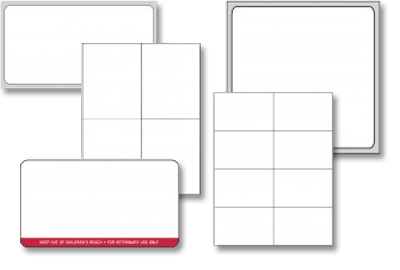Like many problems, prevention is the best remedy. Here are useful steps you can take to increase efficiency, minimize frustrations and problem solve a solution when options are scarce.
Veterinary Compatible Labels
First, order labels designed for your specific printer. For example, DYMO, Zebra and generic thermal printers have a mechanism that detects a black mark, notch or hole located between the labels on the role. Sensing the mark, notch or hole allows the printer to output the amount of labels you specify and ensure that they are cut in the right spot.
For example, UAL produces labels that are designed for the specific requirements of DYMO, Zebra and generic thermal printers.
As for laser printers, due to their sheet fed design, they don’t require a sensing device.
So, to ensure smooth processing, look for a product description that specifies the labels are compatible with your printer. Then procure labels that are built for the one you use.
Label Formats
DYMO, Zebra and common thermal and laser printers have print-ready format options that fit common office applications including:
- Prescriptions and medications
- Mailing and shipping
- Files and binders
- Badges
- Assets and barcoding
For example, prescription and medication labels are a common speciality printing application used in veterinary practices. But, whether it’s a label for prescriptions or one used for shipping, use a label format designed for that specific application. It will reduce label waste and expedite the printing process.
Furthermore, pay attention to the label adhesive and facestock. In veterinary and healthcare facilities, wearing latex gloves is a common job requirement. A glove-safe adhesive allows you to handle labels, trouble free.
In addition, check the label temperature use range. If a test tube or vial requires refrigeration, the adhesive needs to perform in cold temperatures. So does a shipping label.
Taking these steps prevent frustrations and unnecessary label reprints.
Summing up, obtain the items you need for the applications you print. For example, UAL stocks numerous formats that increase printing efficiencies. And, look for the label temperature use range. You can find these specific details in product descriptions.
Printing Problem Solving
Hot and cold weather, dust, chads and label loading errors are another source of printer efficiency drain. Here are a few prevention tips:
- Acclimate your label supply - 70 degrees and 45% humidity are ideal - this should prevent jams, and label curl, wrinkling and puckering
- Store roll labels horizontally not on end to prevent adhesive ooze
- Fan the stack of laser labels before printing to prevent the sheets from sticking together
- Use canned air to clean dust and chads from your printer. This will ensure sensors accurately read the mark, notch or hole and print correctly
- Make sure you load a thermal label roll with the sensor marks in line with the sensor position. Otherwise the printer can’t read the marks which causes inaccurate processing
Read more about effective label processing for cold weather, hot weather and additional printer troubleshooting tips in the UAL Blog.
United Ad Label specializes in developing labels that meet your needs. From specific formats to adhesives and face stocks that perform effectively, we have over 4,000 products that are sure to meet your applications. Browse our website or contact us to learn more.
